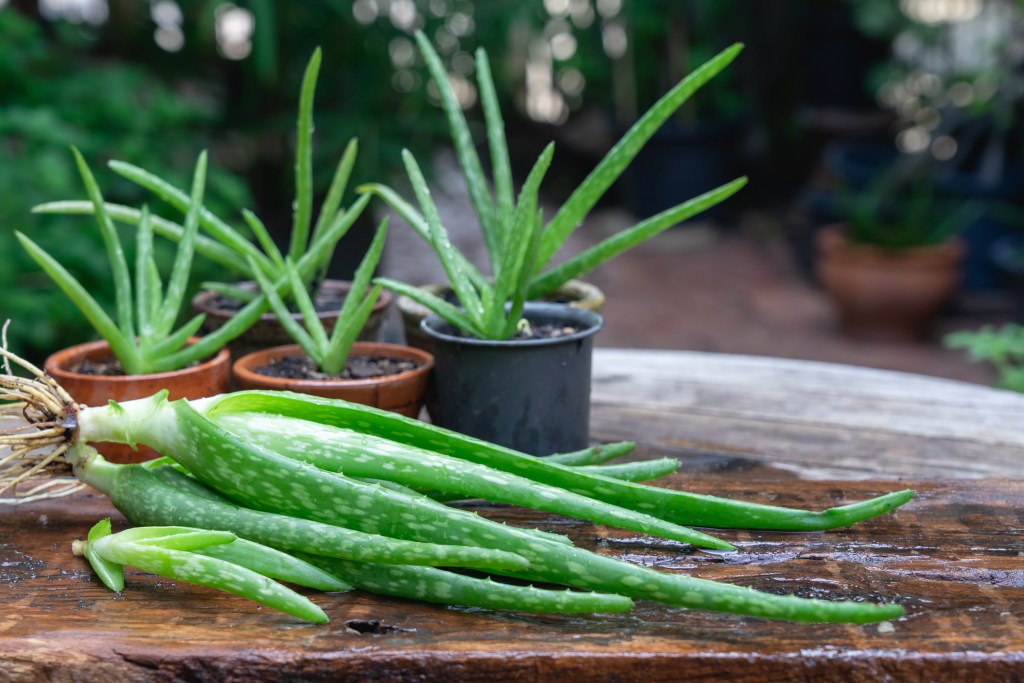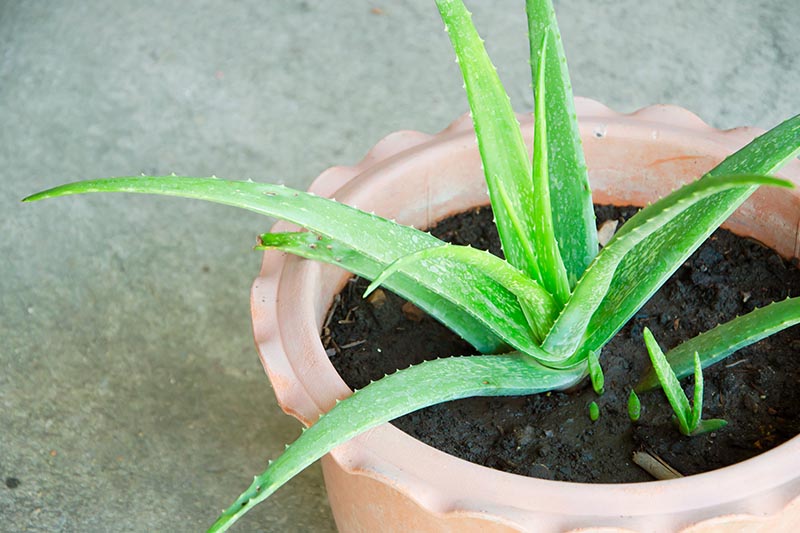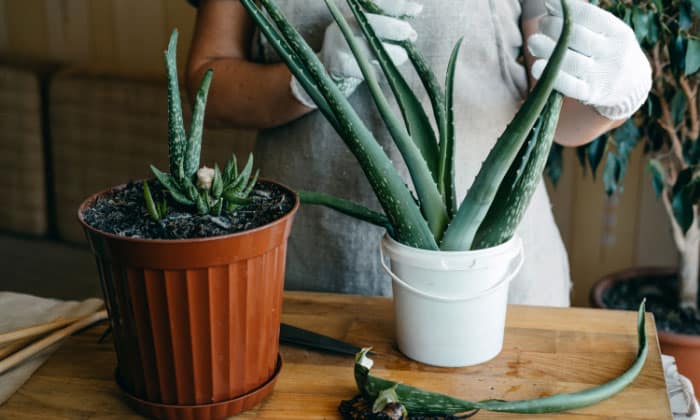Nurturing the Perfect Environment for Aloe Vera
Creating an ideal environment is crucial for aloe vera to grow rapidly and thrive. Aloe vera plants require bright, indirect sunlight to photosynthesize and produce the energy needed for growth. Placing the plant near an east- or west-facing window is perfect, as it provides gentle, indirect sunlight. However, direct sunlight can be detrimental, so it’s essential to use a sheer curtain to filter the sun’s rays.
Watering is another critical aspect of aloe vera care. Overwatering is the most common cause of death in aloe vera plants, so it’s vital to water sparingly. Water the plant when the soil is dry to the touch, usually every 7-10 days in the summer and less often in the winter. Use room-temperature water, as cold water can shock the roots. A well-draining potting mix is also essential to prevent waterlogged soil.
Temperature is also a crucial factor in aloe vera growth. Aloe vera prefers temperatures between 65-80°F (18-27°C), making it an ideal plant for indoor spaces. Avoid placing the plant near heating or cooling vents, fireplaces, or drafty windows, as sudden temperature fluctuations can stress the plant.
Choosing the right potting mix and container size is also vital for aloe vera growth. A potting mix specifically designed for cacti and succulents is perfect, as it drains excess water and provides the necessary nutrients. Select a container that is only slightly larger than the plant’s root system, as this will prevent the soil from becoming too wet.
By providing the right amount of sunlight, water, and temperature, and using a well-draining potting mix and suitable container, you’ll be well on your way to creating an ideal environment for your aloe vera to grow rapidly and thrive. Remember, the key to growing aloe vera fast is to replicate its natural habitat and provide the necessary care and attention.
Mastering the Art of Watering: Tips for Aloe Vera Enthusiasts
Watering is a crucial aspect of aloe vera care, and getting it right can make all the difference in promoting healthy growth and preventing common problems. When it comes to watering aloe vera, the key is to strike a balance between providing enough moisture and avoiding overwatering. Aloe vera plants prefer to dry out slightly between waterings, so it’s essential to check the soil moisture regularly.
To determine when to water your aloe vera, stick your finger into the soil about an inch deep. If the soil feels dry, it’s time to water. If it’s still moist, wait a few more days before checking again. Watering once a week is a good rule of thumb, but this may vary depending on the climate, potting mix, and time of year.
When watering, use room-temperature water and avoid getting water on the leaves to prevent fungal diseases. Water at the soil level, making sure the pot drains well to prevent waterlogged soil. A good way to water aloe vera is to soak the pot in a sink or bowl of water for about 10-15 minutes, allowing the plant to absorb the water it needs.
Overwatering is a common mistake that can lead to root rot and other problems. To avoid overwatering, make sure the pot has good drainage holes and avoid watering too frequently. If you notice the leaves becoming soft and mushy, it’s likely a sign of overwatering. On the other hand, underwatering can cause the leaves to become wrinkled and shriveled.
By mastering the art of watering, you’ll be able to provide your aloe vera with the right amount of moisture to promote healthy growth and prevent common problems. Remember, the key to growing aloe vera fast is to provide the right conditions, including proper watering, and to monitor your plant’s responses to different care techniques.
Fertilizing for Success: Choosing the Right Nutrients for Aloe Vera
Fertilizing aloe vera is an essential step in promoting healthy growth and maximizing its potential. Aloe vera plants require a balanced diet of nutrients to thrive, and using the right type of fertilizer can make all the difference. When it comes to fertilizing aloe vera, it’s essential to choose a balanced fertilizer that provides the necessary nutrients for growth.
A balanced fertilizer typically contains a mix of nitrogen, phosphorus, and potassium (NPK). Nitrogen promotes leaf growth, phosphorus supports root development, and potassium helps with overall plant health. Aloe vera plants prefer a slightly acidic to neutral soil pH, so it’s essential to choose a fertilizer that is formulated for cacti and succulents.
When selecting a fertilizer, look for a product that is specifically designed for cacti and succulents. These fertilizers typically have a lower nitrogen content and a higher phosphorus content, which is ideal for aloe vera plants. Avoid using fertilizers that are high in nitrogen, as this can cause the plant to become leggy and weak.
It’s also essential to avoid overfertilizing, as this can cause more harm than good. Overfertilizing can lead to an overabundance of nutrients in the soil, which can cause the plant to become stressed and vulnerable to disease. To avoid overfertilizing, start with a small amount of fertilizer and gradually increase the dose as needed.
Some popular fertilizers for aloe vera include Miracle-Gro Cactus, Palm & Citrus Food, and Schultz Cactus & Succulent Food. These fertilizers are specifically designed for cacti and succulents and provide the necessary nutrients for healthy growth.
By fertilizing your aloe vera plant with the right type of fertilizer, you’ll be able to provide it with the necessary nutrients for growth and help it reach its full potential. Remember, fertilizing is just one part of the equation when it comes to growing aloe vera fast. By combining fertilizing with proper watering, pruning, and repotting, you’ll be able to create a thriving and healthy aloe vera plant.
Pruning and Propagation: Encouraging Healthy Growth and Multiplication
Pruning and propagation are essential techniques for promoting healthy growth and encouraging multiplication in aloe vera plants. Pruning helps to maintain the plant’s shape, encourages new growth, and prevents the plant from becoming leggy. Propagation, on the other hand, allows you to create new plants from leaf cuttings or offsets, which can be used to share with friends or expand your collection.
To prune an aloe vera plant, start by removing any dead or damaged leaves. Use a sharp, sterile knife or pruning tool to cut the leaves at the base, making sure to leave a small amount of stem attached to the plant. This will help the plant to heal quickly and reduce the risk of infection.
Next, remove any leggy or overgrown stems, cutting them back to about half their length. This will help to encourage new growth and maintain the plant’s shape. Finally, remove any offsets or baby plants that have formed around the base of the mother plant. These can be used to propagate new plants, which can be grown in a separate pot.
Propagating aloe vera plants is a relatively simple process that can be done using leaf cuttings or offsets. To propagate using leaf cuttings, start by selecting a healthy leaf with a long stem. Cut the leaf from the plant, leaving about an inch of stem attached to the leaf. Allow the leaf to dry for a few days, which will help to form a callus over the wound. Then, plant the leaf in a pot filled with well-draining soil, and water sparingly until roots develop.
Offsets, on the other hand, can be propagated by simply twisting or cutting them from the mother plant. Plant the offset in a pot filled with well-draining soil, and water sparingly until roots develop. Keep the soil moist but not waterlogged, and provide bright, indirect light until the new plant is established.
By pruning and propagating your aloe vera plant regularly, you can encourage healthy growth and multiplication, and create new plants to share with friends or expand your collection. Remember to always use sterile tools and follow proper propagation techniques to minimize the risk of infection and ensure successful propagation.
Pest Control and Common Problems: Troubleshooting Aloe Vera Issues
Aloe vera plants are generally hardy and resistant to pests and diseases, but they can still be affected by common problems. Mealybugs, spider mites, and root rot are some of the most common issues that can affect aloe vera plants. In this section, we’ll discuss how to diagnose and treat these issues using organic and chemical methods.
Mealybugs are small, white, cottony insects that feed on the sap of aloe vera plants. They can cause stunted growth, yellowing leaves, and a sticky substance on the leaves. To control mealybugs, use a mild dish soap solution or insecticidal soap. Spray the solution on the affected areas, making sure to cover all surfaces of the plant.
Spider mites are tiny, spider-like insects that feed on the sap of aloe vera plants. They can cause yellowing leaves, stunted growth, and a fine webbing on the leaves. To control spider mites, use a neem oil solution or insecticidal soap. Spray the solution on the affected areas, making sure to cover all surfaces of the plant.
Root rot is a common problem that can affect aloe vera plants, especially if the soil is too wet or waterlogged. It can cause the roots to rot, leading to yellowing leaves, stunted growth, and eventually, plant death. To prevent root rot, make sure the soil is well-draining and avoid overwatering. If you suspect root rot, repot the plant in fresh, well-draining soil, and trim away any affected roots.
In addition to these common problems, aloe vera plants can also be affected by other issues, such as scale, aphids, and fungal diseases. To prevent these issues, make sure to provide your aloe vera plant with good air circulation, avoid overwatering, and fertilize regularly.
By being aware of these common problems and taking steps to prevent them, you can help keep your aloe vera plant healthy and thriving. Remember, prevention is key, so make sure to monitor your plant regularly and take action at the first sign of trouble.
Repotting and Soil Refreshment: Giving Your Aloe Vera a Fresh Start
Repotting aloe vera every 2-3 years is essential to refresh the soil and provide a larger pot if necessary. This process can help to revitalize the plant, promote healthy growth, and prevent the soil from becoming depleted of nutrients. In this section, we’ll discuss the importance of repotting aloe vera and provide tips on how to choose the right potting mix and handle the roots during repotting.
When to repot aloe vera? The best time to repot aloe vera is during the spring or summer months when the plant is actively growing. Avoid repotting during the fall or winter months when the plant is dormant, as this can cause stress and potentially lead to disease.
How to choose the right potting mix? When selecting a potting mix for aloe vera, look for a well-draining mix that is specifically designed for cacti and succulents. Avoid using regular potting soil, as it can retain too much water and cause root rot. A good potting mix should contain a combination of peat moss, perlite, and vermiculite, which will provide good drainage and aeration for the roots.
How to handle the roots during repotting? When repotting aloe vera, it’s essential to handle the roots with care. Gently remove the plant from its pot, taking care not to damage the roots. If the roots are circling or growing out of the pot, use a sharp, sterile knife or pruning tool to trim them back. This will help to encourage new growth and prevent the roots from becoming pot-bound.
What size pot to use? When repotting aloe vera, choose a pot that is only slightly larger than the previous one. Aloe vera plants prefer to be slightly root-bound, so avoid using a pot that is too large. A good rule of thumb is to choose a pot that is 1-2 sizes larger than the previous one.
By repotting aloe vera every 2-3 years and providing a fresh start, you can help to promote healthy growth and prevent the soil from becoming depleted of nutrients. Remember to choose the right potting mix, handle the roots with care, and select a pot that is only slightly larger than the previous one.
Monitoring and Adjusting: Fine-Tuning Your Aloe Vera Care Routine
Monitoring your aloe vera’s health and adjusting your care routine accordingly is crucial for achieving rapid growth and optimal health. By observing your plant’s responses to different care techniques, you can make adjustments to optimize growth and prevent common problems.
How to monitor your aloe vera’s health? Start by observing the plant’s leaves, stems, and roots. Check for signs of stress, such as yellowing or droopy leaves, and adjust your care routine accordingly. Also, monitor the plant’s growth rate, and adjust your fertilization and pruning schedule as needed.
What to look for when monitoring your aloe vera’s health? Look for signs of stress, such as yellowing or droopy leaves, and adjust your care routine accordingly. Also, monitor the plant’s growth rate, and adjust your fertilization and pruning schedule as needed. Check for signs of pests or diseases, such as mealybugs, spider mites, or root rot, and take action promptly to prevent the problem from spreading.
How to adjust your care routine? Based on your observations, adjust your care routine to optimize growth and prevent common problems. For example, if you notice that your aloe vera is not getting enough light, consider moving it to a brighter location or using grow lights. If you notice that your aloe vera is getting too much water, adjust your watering schedule to prevent overwatering.
By monitoring your aloe vera’s health and adjusting your care routine accordingly, you can achieve rapid growth and optimal health. Remember to observe your plant’s responses to different care techniques, and make adjustments to optimize growth and prevent common problems.
Some common adjustments to make to your care routine include: adjusting the amount of light your aloe vera receives, adjusting the watering schedule, adjusting the fertilization schedule, and pruning or propagating your aloe vera as needed. By making these adjustments, you can optimize growth and prevent common problems, and achieve rapid aloe vera growth.
Conclusion: Putting it All Together for Rapid Aloe Vera Growth
By following the tips and guidelines outlined in this article, you can unlock the secrets to rapid aloe vera growth and enjoy the many benefits of this incredible plant. Remember to provide your aloe vera with the right amount of sunlight, water, and temperature, and to fertilize regularly to promote healthy growth.
Pruning and propagation are also essential for encouraging healthy growth and multiplication, and by monitoring your aloe vera’s health and adjusting your care routine accordingly, you can optimize growth and prevent common problems.
Repotting and soil refreshment are also crucial for giving your aloe vera a fresh start, and by choosing the right potting mix and handling the roots with care, you can ensure that your plant thrives.
Finally, remember to be patient and observant, as aloe vera growth can be slow and unpredictable. By following these tips and guidelines, you can achieve rapid aloe vera growth and enjoy the many benefits of this incredible plant.
Some final tips and reminders for achieving rapid aloe vera growth include: providing bright, indirect light, watering sparingly, fertilizing regularly, pruning and propagating regularly, and repotting every 2-3 years. By following these tips and guidelines, you can unlock the secrets to rapid aloe vera growth and enjoy the many benefits of this incredible plant.
Thank you for reading this article on how to grow aloe vera fast. We hope that you have found the information helpful and informative, and that you will be able to use it to achieve rapid aloe vera growth and enjoy the many benefits of this incredible plant.







